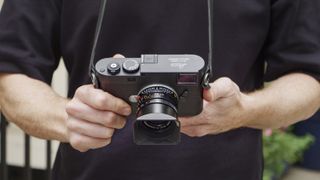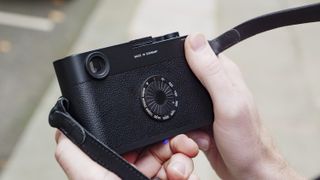Leica recently announced the M11-D, the only digital camera I was lucky enough to use during the day while walking around London for street photography. It follows the Leica M11, M11-P and M11 Monochrom with one trick – it doesn’t have a screen.
Instead of a rear screen, the M11-D has an ISO dial, which is a throwback to older Leica cameras, such as the Leica MP. By removing the immediate feedback that the screen provides, the M11-D is designed to return users to analog basics, while still having some digital tools hidden inside, such as the ability to adjust the ISO for each shot.
There will be a select group of people for whom the M11-D makes perfect sense. It’s a digital camera designed to provide the closest analog shooting experience, using a full-frame 60.4MP sensor with a high-quality image, without the excessive cost of video and development.

Having recently reviewed the analog Leica MP, I was in a great position to compare and contrast analog and digital cameras, both stripped back and fully adjustable. Did the Leica compact, and especially the price, M11-D live up to my expectations? Is the screenless thing just a rumor? Read on to find out.
No cover, no problem
Before leaving with the M11-D, I took some time to familiarize myself with its screenless body. I take pictures with a phone or a digital camera, and not having a screen to record or, seeing them directly after I took them was an uncomfortable feeling, to begin with.
When I stopped having a screen, however, I found it liberating. There are no extensive lists of camera settings to choose from – although this was confusing at first as there is no way to change other camera settings (I’ll get into that later).
No screen also means that you won’t get carried away with the playback of images directly after you’ve taken them instead of just enjoying the moment. I like to look at the pictures right away to make sure they look good. Didn’t get it the first time? Oh well, just take another one. There is no risk of such addictions with the M11-D.
Without fast image playback, your focus on accessing camera settings and technical settings is maximized. This kind of attention also extends to photography techniques such as taking photos when you are doubly aware of your subject’s position, etc.

I should make it clear that the viewfinder of the M11-D is not an EVF like in the Leica Q3 and other mirrorless cameras (which mimics a screen), but an optical viewfinder. The multi-frame camera has a frame selector to show what will be in your shot (35/135mm, 50/75mm or 28/90mm lens apertures – I had a Leica 35mm f/2 Summicron-M ASPH lens), including a split image. in the center box you aim to make sure the focus is sharp where you want it. This is a slow process with steep waves.
Of course, there is no screen and there is no autofocus that was difficult. However, despite the need for manual focus and selection of aperture and shutter, the M11-D offers several modern tools that are not enjoyed by analog, such as auto ISO (based on shutter speed and aperture) and changing the ISO for each image. , unlike a roll of film that is limited to one information.
There’s also a custom LED coating on the color palette, including on the graphic lines of your windshield. For example, an arrow indicates when the light is too bright or too dark, fed by the camera’s exposure meter.
There are other advantages to the M11-D’s compact design. It’s about 20% lighter than its digital counterparts with a window, weighing 540g for the body alone (Leica lenses are lighter, too). Battery life is also excellent, rated at 700 shots when using rangefinder mode, and extended to 1,700 shots using Leica’s ‘adapted shooting’ mode.
I had a great afternoon walking around London with the Leica M11-D. It took me back to the basics of photography, developed my skills, and ultimately helped me be present in the moment. I’ve included some of my favorites below.
A modern twist
For all its design features, the M11-D offers a number of advanced features that shouldn’t hinder your analog experience. There is a smart display wheel with your finger, plus an active button on top of the plate that performs several functions, including showing the battery life and remaining shots on the LED screen, including starting a connection with the Leica Fotos program.
You have two choices for uploading your photos: connect via Bluetooth to the Leica Fotos app on your phone or tablet or, like most digital cameras, put the photos on a memory card on your computer when you have access (the camera also has 256GB or so of internal memory). Sending images to the app isn’t the same as sending rolls of film to the lab and waiting days or weeks for the scales to arrive, but the M11-D’s delay is critical.
Those who don’t mind modern touch can view and control the M11-D remotely using the Leica Fotos app on a phone or tablet.
Whatever Leica Fotos you are using, the first pairing process is easy, but what really impressed me was how easy it is to reset the camera when the connection is broken, such as when you turn the camera on and off. Resetting requires only pressing the button for five seconds – a nice touch is that the LED indicator on the lighting equipment shows when you have pressed the button. This Bluetooth camera-to-phone connection is as simple and reliable as I’ve seen before.
As I mentioned before, some functions cannot be accessed directly through the camera, and instead are available in the camera options in the Leica Fotos application. One example is the activation of Content Guides, which started in M11-P, and must be enabled using the app.
Looking at my photos, there were a lot of hits and misses. This comes with a handheld camera module with moving heads. One thing they do have in common, however, is Leica’s unique color palette and black DNG color.
More than image quality, the M11-D presented a dream and to me, it sounds better than any digital Leica. You feel like you’re shooting analog, but you also get the guarantees and conveniences that digital camera technology brings, should you need it. For professional photographers, a camera without a screen can be the gift that keeps on giving.
You might like it too
#Street #photography #Leica #M11D #closest #Ive #digital #camera